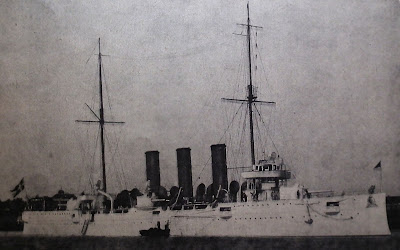 |
| The Swedish Royal Navy's armoured cruiser Fylgia visiting Antwerpen in 1912. |
On the eve of World War I, the Royal Swedish Navy appears to have been in a fairly good shape, with a number of modern - or modernized - ships of different types. As Sweden was able to maintain its neutral status, the navy ships were not directly involved in the war. However, the Royal Navy played an important role in protecting Swedish territorial waters during the war.
In March 1912 the Swedish magazine Hvar 8 Dag (Every 8th Day) published an overview of the Royal Navy, written by Captain Erik Hägg. In his article Hägg listed the number and type of ships at the time:
- 12 First class battleships
- 1 Armoured cruiser
- 5 Torpedo cruisers
- 8 Destroyers (one of them was being built)
- 31 First class torpedo boats
- 22 Second class torpedo boats
- 2 mineships (one of the two was under construction)
- A number of submarines
In addition the Royal Swedish Navy had a number of older ships, built during the 1860s and the 1870s, which were used solely for local defense purposes.
Here are some of the pictures Hägg used in his article as examples for the different types of navy ships:
 |
| First class battleship Oscar II (in service since 1907). It had a max. speed of 18 knots The number of crew was 340.. |
 |
| The armoured cruiser Fylgia was about the same size as the Oscar II, but because of lighter armour it was faster, with max. speed of 23 knots. |
 |
| The torpedo cruiser Class Uggla and the other four torpedo cruisers were built during the years 1897 - 1900. |
 |
| First class torpedo boat Castor. |
 |
| The Hvalen was the only submarine not built in Sweden. It was designed and built by Fiat San Giorgio in Spezia. The submarine, which had a crew of 17, reached a speed of 8 knots while under water. |
 |
| Second class submarine. |
 |
| A model of the destroyer Vale. |
 |
| Torpedo excercise |
No comments:
Post a Comment